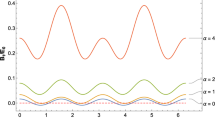Abstract
We present a model that allows one to build structures that evolve continuously from classical to quantum, and we study the intermediate situations, giving rise to structures that are neither classical nor quantum. We construct the closure structure corresponding to the collection of eigenstate sets of these intermediate situations, and demonstrate how the superposition principle disappears during the transition from quantum to classical. We investigate the validity of the axioms of quantum mechanics for the intermediate situations.
Similar content being viewed by others
References
D. Aerts, “A possible explanation for the probabilities of quantum mechanics,”J. Math. Phys. 27, 202 (1986).
D. Aerts, “The origin of the nonclassical character of the quantum probability model,” inInformation, Complexity, and Control in Quantum Physics, A. Blanquiereet al., eds. (Springer, Berlin, 1987).
D. Aerts, “A macroscopical classical laboratory situation with only macroscopical classical entities giving rise to a quantum mechanical probability model,” inQuantum Probability and Related Topics, Vol. VI, L. Accardi, ed. (World Scientific, Singapore, 1991).
M. Czachor, “On classical models of spin,”Found Phys. 5, 3, 249 (1992).
D. Aerts, T. Durt, and B. Van Bogaert, “Quantum probability, the classical limit and non-locality,” inSymposium on the Foundations of Modern Physics, T. Hyvonen, ed. (World Scientific, Singapore, 1993).
D. Aerts and B. Van Bogaert, “A mechanical classical laboratory situation with a quantum logic structure,”Int. J. Theor. Phys. 10, 1893 (1992).
D. Aerts, T. Durt, A. A. Grib, B. Van Bogaert, and R. R. Zapatrin, “Quantum structures in macroscopical reality,”Int. J. Theor. Phys. 32, 3, 489 (1993).
D. Aerts, T. Durt, and B. Van Bogaert, “A physical example of quantum fuzzy sets, and the classical limit,” inProceedings of the first International Conference on Fuzzy Sets and Their Applications, Tatra Montains Math. Publ. 1, 5 (1992).
D. Aerts, “Quantum structures, separated physical entities and probability,”Found. Phys. 24, 227 (1994).
C. Piron,Foundations of Quantum Physics (Benjamin, New York, 1976).
C. Piron,Mécanique quantique. bases et applications (Presses Polytechnique et Universitaire Romandes, 1990).
D. Aerts, “Description of separated physical entities without the paradoxes encountered in quantum mechanics,”Found. Phys. 12, 1131 (1982).
D. Aerts, “Classical theories and nonclassical theories as special cases of a more general theory,”J. Math. Phys. 24, 2441 (1983).
Author information
Authors and Affiliations
Rights and permissions
About this article
Cite this article
Aerts, D., Durt, T. Quantum, classical and intermediate: An illustrative example. Found Phys 24, 1353–1369 (1994). https://doi.org/10.1007/BF02283037
Received:
Issue Date:
DOI: https://doi.org/10.1007/BF02283037




